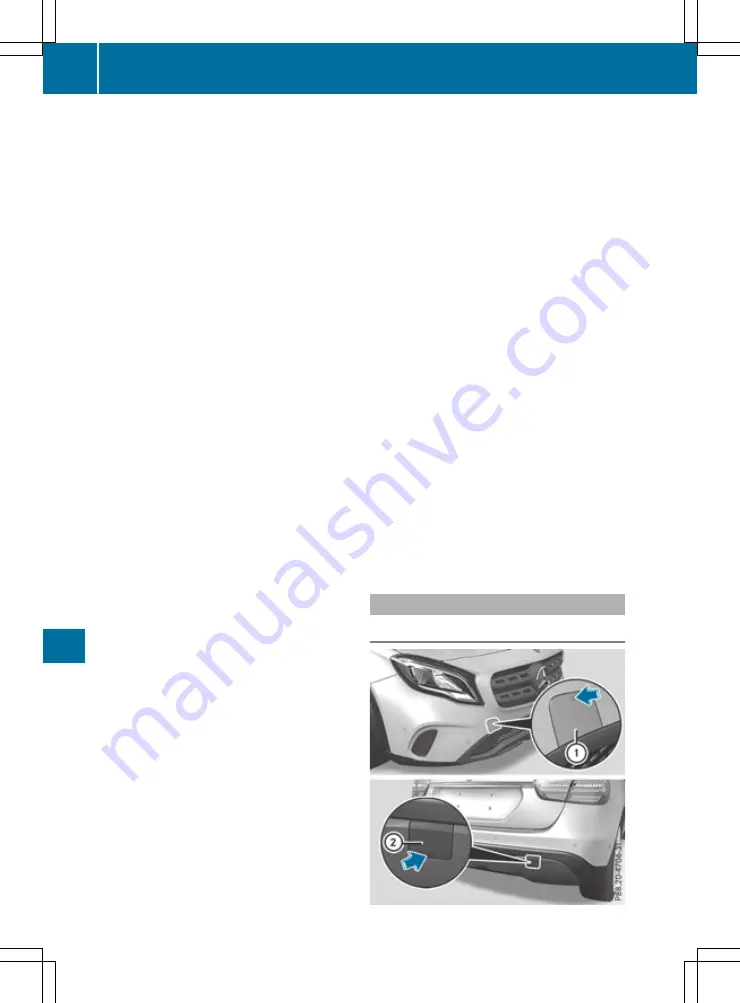
hitch. You could otherwise damage the vehi-
cle.
!
Observe the following points when towing
with a tow rope:
R
Secure the tow rope on the same side on
both vehicles.
R
Make sure that the tow rope is not longer
than legally permitted. Mark the tow rope in
the middle, e.g. with a white cloth
(30 x 30 cm). This will make other road
users aware that a vehicle is being towed.
R
Only secure the tow cable to the towing
eyes or, if available, to the trailer tow hitch.
R
Observe the brake lamps of the towing
vehicle while driving. Always maintain a dis-
tance a distance so that the tow rope does
not sag.
R
Do not use steel cables or chains to tow
your vehicle. You could otherwise damage
the vehicle.
!
Do not use the towing eyes for recovery pur-
poses as this could damage the vehicle. If in
doubt, recover the vehicle with a crane.
!
Pull away smoothly when towing away or
tow-starting a vehicle. If the tractive power is
too high, the vehicles could be damaged.
!
You may tow the vehicle for a maximum of
50km. A towing speed of 50 km/h must not
be exceeded.
For towing distances over 50 km, the front
axle or the entire vehicle must be raised and
transported.
!
To tow vehicles with KEYLESS-GO, use the
key instead of the Start/Stop button. The
automatic transmission may otherwise
switch to position P when you open the driv-
er's or front-passenger door which could
damage the transmission.
!
Vehicles with automatic transmission must
not be tow-started. The transmission may
otherwise be damaged.
Observe the legal requirements for the relevant
countries when towing and tow-starting.
It is better to have the vehicle transported than
to have it towed.
If the vehicle can no longer be driven because of
an accident or breakdown, you have the follow-
ing options:
R
transporting the vehicle
As a rule, you should have the vehicle trans-
ported.
R
towing the vehicle with a tow rope or tow bar
Only tow the vehicle in exceptional cases.
The battery must be connected and charged.
Otherwise, you:
R
cannot turn the key to position
2
in the igni-
tion lock
R
cannot release the electric parking brake
R
cannot shift the transmission to position
i
on vehicles with automatic transmission
The function of the electric parking brake and
the parking lock is dependent on the on-board
voltage.
If the on-board voltage is low or if there is a sys-
tem malfunction:
R
it may not be possible to apply the released
parking brake or
R
it may no longer be possible to shift the trans-
mission to position
j
Switch off non-essential consumers, e.g. the
radio.
Deactivate the automatic locking feature before
towing the vehicle (
Y
page 229). You could oth-
erwise be locked out when pushing or towing
the vehicle.
Deactivate tow-away protection before the vehi-
cle is towed (
Y
page 77).
Fitting/removing the towing eye
Fitting the towing eye
328
Towing away and tow-starting
Breakdown
assistance
















































